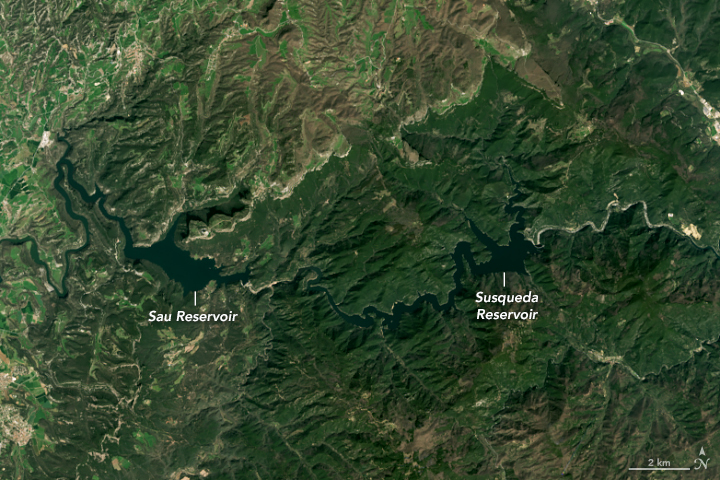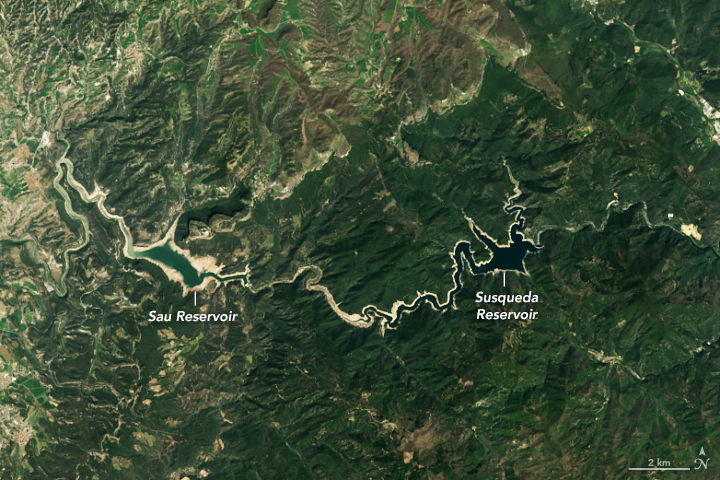Catalonia’s reservoirs are drying up
Catalonia received just 14% of expected rainfall in March and April, leading to water use restrictions and ecological concerns.
The drought started in Spain before the heat wave, and it has been raining less than usual for 36 months. Now the water reservoirs in the north-east are only seven percent full – and the prospects are poor.

Record temperatures with 38.8 degrees – in April. Spain is currently experiencing a historic heat wave. But the state of emergency has been in force in the country for a long time. Because the heat was preceded by a long drought. Spain has had 36 consecutive months of below-average rainfall.
Catalonia received just 14 percent of the rainfall in March and April that would have been expected based on averages between 2009 and 2021. From the air, you can see this in the reservoirs, which have literally shrunk: in Catalonia in the north-east and in Andalusia in the south, their levels have fallen to around 25 percent.
NASA: The Sau Reservoir (Pantà de Sau) and the Susqueda Reservoir (Pantà de Susqueda) are about 108 kilometers (67 miles) inland from Barcelona and supply the metropolitan area with drinking water. The low water levels of the reservoirs can be seen in the image below (right), acquired by the Operational Land Imager (OLI) on Landsat 8 on April 12, 2023. The image on the left was acquired in March 2021, when water levels in the reservoirs were higher.


According to the Catalan Water Agency, the Sau Reservoir (left) stood at only 7 percent of its capacity on April 25, 2023. The Susqueda Reservoir (right) also had diminished water levels. That reservoir stood at 38 percent of total capacity on April 25. Across all of Catalonia, reservoirs averaged about one-quarter of capacity.
Dams built along the Ter River created these reservoirs in the 1960s and they have become a vital source of water for Catalonia’s residents and farmers.
“Seasonal droughts are typical of Catalonia’s Mediterranean climate—including in the Ter watershed, which runs from the Catalan Pyrenees to the Mediterranean Sea,” said Albert Ruhi, an ecologist at the University of California, Berkeley. “But over the past few months, the lack of precipitation and snowpack has led to the driest spring since 1990 for the Ter River.” Ruhi, originally from Girona, just east of the reservoirs, studies freshwater ecology and how the Ter River is changing over time.
Notice the tan fringes of exposed rock around the water in the reservoirs. These are areas that were underwater when the water level was closer to capacity, a phenomenon referred to as a “bathtub ring.” Falling water levels in the Sau Reservoir have exposed more than just rock. The belfry of an 11th-century church and a nearby village, which have been mostly submerged since the construction of the dam, became visible in recent months. The belfry is occasionally exposed during times of low water; this year, the church stands several meters above the water line. Note that these features are too small to be seen in these images.
Although much of Spain is experiencing a drought this spring, Catalonia in the northeast has been hit especially hard. Over March and April, the region has received only about 14 percent of expected rainfall based on 2009-2021 averages.
“The lack of spring rain and snowmelt means that this year’s dry season will be twice or even three times as long,” Ruhi said. “This could lead to ecological impacts such as fish mortality and algal blooms.”
In some places in Catalonia, officials have turned to restricting water use among residents and farmers. In the small town of L’Espluga de Francoli, 97 kilometers west of Barcelona, household water supplies are turned off every night between 10 p.m. and 7 a.m. local time. Personal water use has been limited to 230 liters (61 gallons) per person per day in Catalan municipalities representing almost 6 million people.
The lack of rain has been accompanied by high temperatures, with 2022 ranking as Catalonia’s warmest year on record.
About the Author: CLIMATE STATE
POPULAR
COMMENTS
- Robert Schreib on Electricity generation prices may increase by as much as 50% if only based on coal and gas
- Robert Schreib on China made a historic commitment to reduce its emissions of greenhouse gases
- Lee Nikki on COP30: Climate Summit 2025 – Intro Climate Action Event
- Hollie Bailey on Leaders doubled down on fossil fuels after promising to reduce climate pollution
- Malcolm R Forster on Mythbusters tests global warming theory – does CO2 warm air?
Hallo Hr. Machens –
Dürre, Hitzerekorde und Rückgang der Niederschläge sind menschgemacht. Der Verlust an Verdunstungsfähigen Landschaften verursacht (schon lange vor der Industrialisierung) eine seit Jahrzehnten auch beobachtete, global sinkende, relative Luftfeuchtigkeit mit entsprechendem Verlust an Wolkenalbedo.
Dieser Albedoverlust summiert sich seit dem Jahr 2000 auf ~ 1,5W/m² und ist damit mehr als doppelt so stark, wie der Strahlungsantrieb durch CO2 und Treibhauseffekt im selben Zeitraum.
Wasser-, Regenrückhalt & Bewässerung sind deshalb die weitaus dringlichere, schnellwirkendere und auch kostengünstigere Klimaschutzmassnahme – im Vergleich zur Minderung der Klimagase.
Mehr Info: https://climateprotectionhardware.wordpress.com/